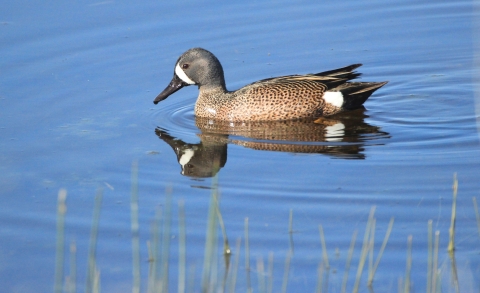Seasons of Wildlife
Winter – Winters are quiet in the wetland management district wetland management district
A wetland management district is a U.S. Fish and Wildlife Service office that manages waterfowl production areas in one or more counties. Waterfowl production areas are small natural wetlands and grasslands that provide breeding, resting and nesting habitat for waterfowl, shorebirds, grassland birds and other wildlife. The Fish and Wildlife Service acquires waterfowl production areas under the authority of the Migratory Bird Hunting and Conservation Stamp Act, primarily using funds from the sale of Federal Duck Stamps. The Refuge System’s 38 wetland management districts comprise thousands of waterfowl production areas – almost all in the Prairie Pothole Region of the Northern Great Plains.
Learn more about wetland management district . Resident wildlife are tucked in their burrows hibernating, songbirds and upland birds may be observed in the grasslands and heavier wetland cover, and roaming of coyotes and deer.
Spring – Spring brings the return of migratory bird species looking to nest in the wetland management district. Large flocks of migratory birds can be see using the wetlands as they travel further north.
Summer – In Summer, native grasses mature, prairie flowers bloom, and waterfowl broods can be observed on the wetlands.
Fall – In fall, the wetland management district lands serve as a stopover point for large flocks of migratory waterfowl as they make their way south to the wintering grounds.
Featured Species
The majestic flights of thousands of waterfowl, sandhill cranes, and shorebirds are visible in the wetland management district wetland management district
A wetland management district is a U.S. Fish and Wildlife Service office that manages waterfowl production areas in one or more counties. Waterfowl production areas are small natural wetlands and grasslands that provide breeding, resting and nesting habitat for waterfowl, shorebirds, grassland birds and other wildlife. The Fish and Wildlife Service acquires waterfowl production areas under the authority of the Migratory Bird Hunting and Conservation Stamp Act, primarily using funds from the sale of Federal Duck Stamps. The Refuge System’s 38 wetland management districts comprise thousands of waterfowl production areas – almost all in the Prairie Pothole Region of the Northern Great Plains.
Learn more about wetland management district during spring and fall migration. Endangered whooping cranes are often seen migrating in small groups or with sandhill cranes. Piping plovers, a threatened species, nest in the area each summer. Giant Canada geese, in addition to ducks such as mallards, gadwalls, blue-winged teal, northern pintails, and lesser scaup, are common nesters on the Refuge.
Other birds you may see include northern harriers, marbled godwits, upland sandpipers, western meadowlarks, bobolinks, and more than 200 other species.
Audubon Wetland Management District also provides habitat for wildlife that make the prairie their year-round home. White-tailed deer, coyote, red fox, sharp-tailed grouse, and gray partridge are some of the hardier species that are adapted to North Dakota's climate. The ring-necked pheasant is also a resident whose numbers often decline during severe winters.

